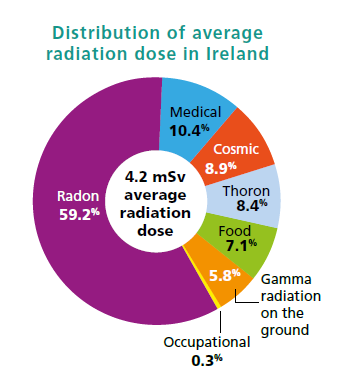Radon is still the main source of radiation exposure for the Irish public, say EPA and HIQA.
- The ‘Ionising Radiation – National Dose Report’ assessed the radiation exposure received from the air we breathe, medical exposures, our diet and exposure to radiation in our environment.
- Over 99% of radiation dose received comes from natural sources of radiation, and medical exposures such as X-rays and CT scans.
- Nearly 60% of the dose is due to the radioactive gas Radon.
- 10 % of the dose comes from medical exposures, mainly from medical imaging.
- 7% comes from our food and drinking water.
- This assessment found that the average dose remains similar to that found a decade ago.
The Environmental Protection Agency (EPA) and Health Information and Quality Authority (HIQA) today published a new assessment of the average radiation doses received by the Irish population. The Ionising Radiation – National Does Report assessed the radiation exposure over the last five years received from the air we breathe, medical exposures, our diet, and exposures to radiation in our environment.
This is an update of a 2014 assessment, and the current assessment found that the average dose remains similar to that found a decade ago. The assessment found that over 99% of the average radiation dose comes from natural sources of radiation, and medical exposures such as X-rays and CT scans. Medical exposure alone can account for just over 10% of a person’s total exposure or dose.
The assessment found:
- Nearly 60% of the dose is due to the radioactive gas Radon in indoor air, with over 8% coming from exposure to another radioactive gas, Thoron.
- 10% of the dose comes from medical exposures, mainly from medical imaging.
- 9% comes from cosmic radiation, of which 2% is due to exposure received if flying.
- 7% comes from our food and drinking water.
- 6% comes from radiation from the ground as gamma radiation.
People in Ireland receive a slightly higher average radiation dose than the European average, mainly due to radon exposure in the home and in the workplace. Radon, a naturally occurring radioactive gas, contributes almost 60% of the annual dose. This is of concern as radon is a major cause of lung cancer.
Over 7% of the average annual radiation dose comes from radiation in food and drinking water, the source of which is mainly naturally occurring radiation.
Radioactivity from artificial sources, such as discharges from nuclear facilities abroad, fallout from historic nuclear weapons testing and past nuclear accidents make up less than 1% of overall exposure.
Dr Micheal Lehane, EPA Director said, “Radon is the largest contributor to radiation dose in Ireland. If there is a high radon level in your home, it is exposing you and your family to unnecessary radiation. The good news is that radon is easy to test for and solutions are available to reduce high levels where necessary. When building a house it is critical to seal the base of the building to prevent radon from getting into your house in the first place. For existing houses, we urge people to test for radon, and remediate if necessary, as this is the only way of protecting you and your family from this cancer-causing gas.”
As part of the assessment, HIQA reviewed radiation exposure to patients, finding that the average amount of radiation from medical exposure has decreased. This is in part due to improvements in the overall reduction of exposure to patients and increased access to new and improved medical imaging.
Mr Sean Egan, HIQA’s Director of Healthcare Regulation, said, “It is encouraging to see the decrease in amounts of ionising radiation received from medical exposures over the past 10 years. Since HIQA began regulating ionising radiation facilities in 2019, we have seen increased compliance with the regulations year-on-year. This means that services are considering how best to use equipment to meet the intended diagnostic or treatment goal while keeping exposure of the patient as low as possible, reducing the risk of harm to patients. We will continue to engage with services to ensure that this good practice continues.”


Leave a Reply